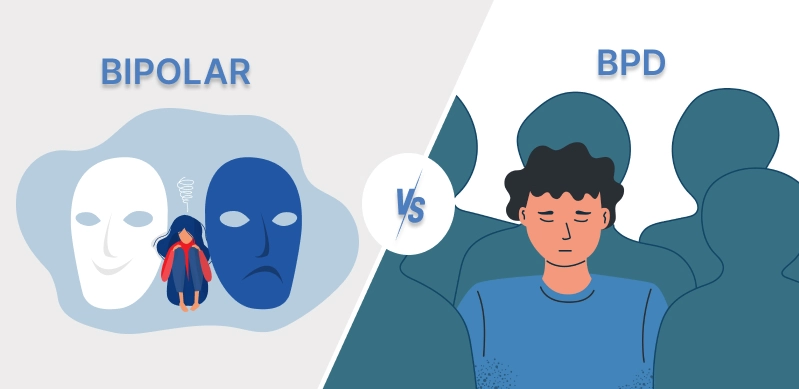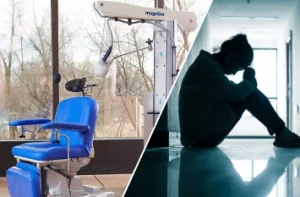
Living with BPD: How Does a BPD Episode Look Like?
Living with BPD: How Does a BPD Episode Look Like? Living with Borderline Personality Disorder (BPD) poses unique challenges as individuals navigate through intense emotions

In mental health, where clarity is often obscured by the complexities of the mind, distinguishing between Borderline Personality Disorder (BPD) and Bipolar Disorder is crucial for accurate diagnosis and effective treatment. Despite some shared symptoms, these two conditions have distinct features that set them apart. Borderline Personality Disorder is characterized by intense, unstable relationships, self-image disturbances, and impulsivity, while Bipolar Disorder involves recurrent episodes of mania and depression.
To unravel the threads of these disorders, let’s embark on a journey through their unique traits, exploring the nuances that make each condition a distinct entity in the landscape of mental health.
Borderline Personality Disorder (BPD) is a complex mental health condition marked by pervasive patterns of instability in interpersonal relationships, self-image, and emotions. Individuals with BPD often experience intense, tumultuous relationships, swinging between idealization and devaluation of others. A profound fear of abandonment underscores their interactions, leading to desperate efforts to avoid real or perceived rejection.
A distinctive hallmark of BPD is the presence of identity disturbances, causing individuals to grapple with a fragmented sense of self. Impulsivity in areas such as spending, substance abuse, and risky behaviors further characterizes this disorder.
While the exact causes of Borderline Personality Disorder (BPD) remain elusive, a combination of genetic, environmental, and neurological factors is believed to contribute to its development. Genetic predisposition plays a role, as individuals with a family history of BPD may be at a higher risk.
Childhood trauma, such as abuse, neglect, or unstable family dynamics, is often considered a significant environmental factor influencing the onset of BPD. Neurobiological factors, including abnormalities in brain structure and function, may also contribute to the manifestation of this disorder.
Genetic Predisposition: Family history of BPD increases susceptibility.
Environmental Factors: Childhood trauma, abuse, neglect, and unstable family environments may contribute.
Neurobiological Factors: Abnormalities in brain structure and function are implicated in the development of BPD.
Understanding these multifaceted factors can provide valuable insights into the complex etiology of Borderline Personality Disorder, offering a foundation for tailored therapeutic approaches and interventions.
Living with Borderline Personality Disorder (BPD) can present unique challenges, but with the right coping strategies, individuals can manage their symptoms and improve their overall well-being.
Here are some effective coping strategies for Borderline Personality Disorder:
Dialectical Behavior Therapy (DBT): DBT is a well-established therapeutic approach designed specifically for individuals with BPD. It focuses on enhancing emotional regulation, interpersonal effectiveness, distress tolerance, and mindfulness.
Mindfulness and Meditation: Practicing mindfulness can help individuals with BPD become more aware of their thoughts and emotions without judgment. Meditation techniques can promote relaxation and reduce the intensity of emotional responses.
Establishing Routine: Creating and adhering to a daily routine provides structure and predictability, which can be comforting for individuals with BPD. Consistency in daily activities contributes to a sense of stability.
Building a Support System: Developing a reliable support network is crucial for individuals with BPD. Having understanding friends family, or participating in support groups can offer validation, empathy, and encouragement.
Emotion Regulation Techniques: Learning to identify and regulate emotions is essential. Techniques such as deep breathing exercises, progressive muscle relaxation, and journaling can be valuable tools for managing intense emotions.
Setting Boundaries: Establishing and maintaining healthy boundaries in relationships helps prevent feelings of rejection or abandonment. Clear communication about personal limits fosters more stable and fulfilling connections.
Self-Care Practices: Prioritizing self-care is vital for individuals with BPD. Engaging in activities that bring joy, relaxation, and a sense of accomplishment contributes to overall mental well-being.
Medication Management: In some cases, medications may be prescribed to address specific symptoms associated with BPD, such as mood swings, anxiety, or depression. It is important to consult with a mental health professional to determine the most appropriate medication plan.
Problem-Solving Skills: Developing effective problem-solving skills can empower individuals with BPD to address challenges in a constructive manner, reducing feelings of helplessness.
Educating Yourself: Learning more about BPD and its symptoms can empower individuals to understand and manage their condition better. Education fosters self-awareness and equips individuals to make informed decisions about their mental health
Bipolar Disorder, formerly known as manic-depressive illness, is a mental health condition characterized by extreme mood swings between periods of intense mania and debilitating depression. Individuals with Bipolar Disorder may experience manic episodes marked by elevated energy levels, impulsive behavior, and heightened creativity.
These episodes are often followed by periods of deep depression, where individuals may feel hopeless, fatigued, and lose interest in activities they once enjoyed. The unpredictable nature of Bipolar Disorder can significantly impact daily life, relationships, and overall functioning.
The disorder is classified into several subtypes, including Bipolar I, Bipolar II, Cyclothymic Disorder, and other specified and unspecified bipolar and related disorders. Understanding the distinct phases of mania and depression is crucial for accurate diagnosis and the development of effective treatment plans for individuals grappling with Bipolar Disorder.
Bipolar Disorder manifests through a spectrum of symptoms that alternate between manic and depressive episodes, each presenting unique challenges for individuals affected.
Manic Episodes:
Elevated Mood: Feelings of intense euphoria or irritability.
Increased Energy: A surge in activity levels and a decreased need for sleep.
Racing Thoughts: Rapid, unpredictable thought patterns.
Impulsivity: Engaging in risky behaviors, such as excessive spending or substance abuse.
Depressive Episodes:
Persistent Sadness: Overwhelming feelings of despair and hopelessness.
Fatigue: Profound tiredness and a lack of energy.
Loss of Interest: Diminished interest or pleasure in activities.
Difficulty Concentrating: Impaired focus and decision-making abilities.
Mixed Episodes:
Simultaneous Symptoms: Elements of both manic and depressive episodes occurring concurrently.
Heightened Suicide Risk: Increased vulnerability due to the combination of intense emotions.
The exact origins of Bipolar Disorder are multifaceted, involving a complex interplay of genetic, neurological, and environmental factors. Understanding these underlying causes is essential for accurate diagnosis and the development of effective treatment strategies.
Genetic Factors:
There is a notable genetic component to Bipolar Disorder, with a higher likelihood of developing the condition if a first-degree relative has been diagnosed. Specific genes associated with neurotransmitter regulation and circadian rhythms may contribute to the hereditary nature of the disorder.
Neurobiological Factors:
Abnormalities in brain structure and function play a pivotal role in Bipolar Disorder. Neurotransmitter imbalances, particularly involving serotonin, dopamine, and norepinephrine, impact mood regulation and contribute to the occurrence of manic and depressive episodes.
Environmental Triggers:
Life events and environmental stressors can act as triggers for the onset of Bipolar Disorder in susceptible individuals. Traumatic experiences, major life changes, or chronic stress may exacerbate genetic predispositions.
Brain Structure and Function:
Structural abnormalities in the brain, such as changes in the size or activity of certain brain regions, have been observed in individuals with Bipolar Disorder. The prefrontal cortex, amygdala, and hippocampus are areas of interest in research exploring these structural variations.
Imbalance in Neurotransmitters:
Dysregulation of neurotransmitters, which are chemical messengers facilitating communication between nerve cells, is a key factor in the manifestation of Bipolar Disorder. Imbalances in serotonin, dopamine, and norepinephrine contribute to mood fluctuations.
Effectively managing Bipolar Disorder involves a multifaceted approach that addresses both the manic and depressive phases. Treatment plans are tailored to individual needs, and a combination of therapeutic interventions and medications is often employed.
Mood Stabilizers:
Medications like lithium, valproic acid, and lamotrigine are commonly prescribed to stabilize mood fluctuations and prevent the recurrence of manic and depressive episodes.
Antipsychotics:
In cases of severe mania or psychosis, antipsychotic medications such as olanzapine or risperidone may be recommended to alleviate symptoms.
Antidepressants:
For depressive episodes, antidepressants like selective serotonin reuptake inhibitors (SSRIs) may be prescribed cautiously, often in combination with mood stabilizers to prevent triggering manic episodes.
Psychotherapy:
Various therapeutic approaches, including Cognitive-Behavioral Therapy (CBT) and psychoeducation, are beneficial in helping individuals manage symptoms, identify triggers, and develop coping strategies.
Electroconvulsive Therapy (ECT):
In some cases, especially when other treatments are ineffective, ECT may be considered for rapid relief of severe symptoms, particularly during acute manic or depressive states.
Hospitalization:
During extreme episodes, hospitalization may be necessary to ensure the safety of the individual and provide intensive treatment and support.
Lifestyle Modifications:
Adopting a stable routine, maintaining regular sleep patterns, and minimizing stress can contribute to symptom management. Regular exercise and a balanced diet also play crucial roles in overall well-being.
Peer Support Groups:
Engaging in support groups or therapy groups with individuals facing similar challenges provides a sense of community, understanding, and shared coping strategies.
Medication Adherence:
Consistent adherence to prescribed medications is paramount for long-term stability. Regular follow-ups with healthcare professionals are crucial to monitor and adjust treatment plans as needed.
Characteristics | Borderline Personality Disorder (BPD) | Bipolar Disorder |
Nature of Mood Episodes | Intense and rapidly shifting emotions, often triggered by interpersonal relationships | Distinct episodes of mania and depression, with more prolonged mood states |
Stability in Relationships | Tendency towards unstable and intense relationships, marked by idealization and devaluation | Relationships may be strained during mood episodes but tend to stabilize between episodes |
Self-Image Disturbances | Frequent identity crises and struggles with a fragmented sense of self | Stable self-image between mood episodes, with identity concerns more linked to mood states |
Impulsivity | Impulsive behaviors such as reckless spending, substance abuse, or risky activities | Impulsivity during manic episodes, but not consistently present |
Onset and Duration | Typically emerges in late adolescence or early adulthood, with symptoms persisting over time | Onset often in late adolescence or early adulthood, with episodic and cyclical patterns |
Treatment Approaches | Dialectical Behavior Therapy (DBT) is a primary therapeutic approach | Medications such as mood stabilizers and psychotherapy, tailored to mood phases |
Bipolar Disorder is not classified as a personality disorder. While both types of mental health conditions share common ground in affecting an individual’s mood, they differ in fundamental ways. Bipolar Disorder, characterized by recurrent episodes of mania and depression, is primarily a mood disorder.
In contrast, personality disorders, including conditions like Borderline Personality Disorder, involve enduring patterns of behavior, cognition, and inner experience that deviate markedly from cultural expectations. The diagnostic criteria, treatment approaches, and underlying causes for Bipolar Disorder and personality disorders are distinct.
It is essential to differentiate between these categories to ensure accurate diagnosis and implement effective treatment strategies tailored to the specific nature of each mental health condition.
Attempting to label one mental health condition as “worse” than another is a complex and subjective endeavor. Bipolar Disorder and Borderline Personality Disorder (BPD) each present unique challenges and the impact of these conditions can vary significantly from person to person.
Bipolar Disorder is characterized by extreme mood swings between mania and depression, affecting a person’s ability to regulate emotions. On the other hand, BPD involves instability in relationships, self-image, and emotions, often leading to intense and tumultuous interpersonal interactions.
Both disorders can significantly disrupt daily life, relationships, and overall well-being.
Borderline Personality Disorder Vs Bipolar Disorder
It becomes evident that each condition has its unique challenges and nuances. While BPD is marked by intense and unstable relationships, self-image disturbances, and impulsivity, Bipolar Disorder involves distinct episodes of mania and depression. Understanding these differences is essential for accurate diagnosis and effective treatment. Rather than comparing their severity, acknowledging the individuality of each disorder paves the way for personalized approaches, emphasizing the importance of seeking professional guidance and support.

Living with BPD: How Does a BPD Episode Look Like? Living with Borderline Personality Disorder (BPD) poses unique challenges as individuals navigate through intense emotions

If you are considering treatment for depression, then chances are that you have heard about

Mental Health Break From Work: Prioritizing Well-being for Greater Productivity Get Instant Relief Now! The concept of taking a mental health break from work has
